Asus RS720Q-E9-RS8, RS720Q-E9-RS8-S User Manual
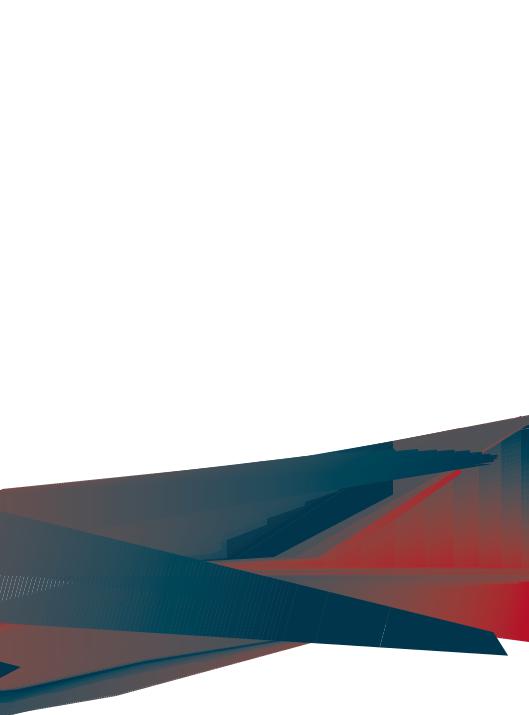
RS720Q-E9-RS8
RS720Q-E9-RS8-S
2U Rackmount Server
User Guide

E15350
Revised Edition V3
April 2019
Copyright © 2019 ASUSTeK COMPUTER INC. All Rights Reserved.
No part of this manual, including the products and software described in it, may be reproduced, transmitted, transcribed, stored in a retrieval system, or translated into any language in any form or by any means, except documentation kept by the purchaser for backup purposes, without the express written permission of ASUSTeK COMPUTER INC. (“ASUS”).
ASUS provides this manual “as is” without warranty of any kind, either express or implied, including but not limited to the implied warranties or conditions of merchantability or fitness for a particular purpose. In no event shall ASUS, its directors, officers, employees, or agents be liable for any indirect, special, incidental, or consequential damages (including damages for loss of profits, loss of business, loss of use or data, interruption of business and the like), even if ASUS has been advised of the possibility of such damages arising from any defect or error in this manual or product.
Specifications and information contained in this manual are furnished for informational use only, and are subject to change at any time without notice, and should not be construed as a commitment by ASUS. ASUS assumes no responsibility or liability for any errors or inaccuracies that may appear in this manual, including the products and software described in it.
Product warranty or service will not be extended if: (1) the product is repaired, modified or altered, unless such repair, modification of alteration is authorized in writing by ASUS; or (2) the serial number of the product is defaced or missing.
Products and corporate names appearing in this manual may or may not be registered trademarks or copyrights of their respective companies, and are used only for identification or explanation and to the owners’ benefit, without intent to infringe.
ii

Contents
Notices ....................................................................................................................... |
vii |
REACH ....................................................................................................... |
vii |
Safety information.................................................................................................... |
viii |
Australia statement notice............................................................................... |
ix |
About this guide........................................................................................................... |
x |
Chapter 1: |
Product Introduction |
|
|
1.1 |
System package contents......................................................................... |
1-2 |
|
1.2 |
Serial number label..................................................................................... |
1-3 |
|
1.3 |
System specifications................................................................................ |
1-4 |
|
1.4 |
Front panel features................................................................................... |
1-7 |
|
1.5 |
Rear panel features.................................................................................... |
1-8 |
|
1.6 |
Internal features.......................................................................................... |
1-9 |
|
1.7 |
LED information........................................................................................ |
1-10 |
|
|
1.7.1 |
Front panel LEDs....................................................................... |
1-10 |
|
1.7.2 |
LAN (RJ-45) LEDs..................................................................... |
1-11 |
|
1.7.3 |
HDD status LEDs....................................................................... |
1-11 |
Chapter 2: |
Hardware Information |
|
|
2.1 |
Removing the server node......................................................................... |
2-2 |
|
2.2 |
Air Duct |
....................................................................................................... |
2-3 |
2.3 |
Central Processing ..................................................................Unit (CPU) |
2-4 |
|
|
2.3.1 ................................................... |
Installing the CPU and heatsink |
2-4 |
2.4 |
System memory.......................................................................................... |
2-7 |
|
|
2.4.1 ...................................................................................... |
Overview |
2-7 |
|
2.4.2 ................................................................ |
Memory Configurations |
2-7 |
2.5 |
Storage ..........................................................................................devices |
2-9 |
|
2.6 |
Expansion ........................................................................................slots |
2-11 |
|
|
2.6.1 ........................................................ |
The PCI Express riser card |
2-11 |
|
2.6.2 ........................................................ |
Installing Mezzanine cards |
2-14 |
|
2.6.3 .................................................. |
Configuring an expansion card |
2-15 |
2.7 |
Backplane ...........................................................and Mid Plane cabling |
2-16 |
|
2.8 |
Removable/optional ...........................................................components |
2-20 |
|
|
2.8.1 ................................................................................ |
System fan |
2-20 |
|
2.8.2 ................................................................ |
Power supply module |
2-22 |
iii

Contents
Chapter 3: |
Installation Options |
|
|
3.1 |
Tool-less Friction Rail Kit.......................................................................... |
3-2 |
|
3.2 |
Rail kit dimensions..................................................................................... |
3-4 |
|
Chapter 4: |
Motherboard Information |
|
|
4.1 |
Motherboard and Mid plane layout........................................................... |
4-2 |
|
|
4.1.1 |
Layout contents ........................................................................... |
4-4 |
4.2 |
Jumpers |
....................................................................................................... |
4-5 |
4.3 |
Internal connectors.................................................................................. |
4-11 |
|
4.4 |
Internal LEDs............................................................................................. |
4-15 |
|
4.5 |
Mid Plane ......................................................................................jumper |
4-17 |
|
Chapter 5: |
BIOS Setup |
|
|
5.1 |
Managing ...........................................................and updating your BIOS |
5-2 |
|
|
5.1.1 ................................................... |
ASUS CrashFree BIOS 3 utility |
5-2 |
|
5.1.2 .................................................................. |
ASUS EZ Flash Utility |
5-3 |
|
5.1.3 ........................................................................ |
BUPDATER utility |
5-4 |
5.2 |
BIOS setup ...................................................................................program |
5-6 |
|
|
5.2.1 ...................................................................... |
BIOS menu screen |
5-7 |
|
5.2.2 ...................................................................................... |
Menu bar |
5-7 |
|
5.2.3 .................................................................................. |
Menu items |
5-8 |
|
5.2.4 ............................................................................ |
Submenu items |
5-8 |
|
5.2.5 ........................................................................... |
Navigation keys |
5-8 |
|
5.2.6 ................................................................................ |
General help |
5-8 |
|
5.2.7 ...................................................................... |
Configuration fields |
5-8 |
|
5.2.8 ............................................................................ |
Pop - up window |
5-8 |
|
5.2.9 ...................................................................................... |
Scroll bar |
5-8 |
5.3 |
Main menu................................................................................................... |
5-9 |
|
|
5.3.1 ..................................................... |
System Date [Day xx/xx/xxxx] |
5-9 |
|
5.3.2 ................................................................ |
System Time [xx:xx:xx] |
5-9 |
5.4 |
Performance ......................................................................Tuning menu |
5-10 |
|
5.5 |
Advanced ........................................................................................menu |
5-11 |
|
|
5.5.1 .................................................................... |
Trusted Computing |
5-12 |
|
5.5.2 ............................................................................ |
ACPI Settings |
5-12 |
|
5.5.3 ........................................................................... |
Smart Settings |
5-12 |
|
5.5.4 .............................................................. |
Super IO Configuration |
5-13 |
|
5.5.5 ................................................. |
Serial Port Console Redirection |
5-13 |
iv

Contents
|
5.5.6 |
Onboard LAN Configuration...................................................... |
5-16 |
|
5.5.7 |
APM........................................................................................... |
5-17 |
|
5.5.8 |
PCI Subsystem Settings............................................................ |
5-18 |
|
5.5.9 |
Network Stack Configuration..................................................... |
5-22 |
|
5.5.10 |
CSM Configuration.................................................................... |
5-23 |
|
5.5.11 |
NVMe Configuration.................................................................. |
5-24 |
|
5.5.12 |
USB Configuration..................................................................... |
5-24 |
|
5.5.13 |
Vcore Adjust.............................................................................. |
5-25 |
|
5.5.14 |
iSCSI Configuration .................................................................. |
5-25 |
|
5.5.15 |
Intel(R) Virtual RAID on CPU..................................................... |
5-25 |
5.6 |
Platform Configuration menu.................................................................. |
5-26 |
|
|
5.6.1 |
PCH Configuration..................................................................... |
5-26 |
|
5.6.2 |
Miscellaneous Configuration...................................................... |
5-28 |
|
5.6.3 |
Server ME Configuration........................................................... |
5-28 |
|
5.6.4 |
Runtime Error Logging............................................................... |
5-29 |
5.7 |
Socket Configuration menu..................................................................... |
5-30 |
|
|
5.7.1 |
Processor Configuration............................................................ |
5-30 |
|
5.7.2 |
Common RefCode Configuration............................................... |
5-32 |
|
5.7.3 |
UPI Configuration...................................................................... |
5-32 |
|
5.7.4 |
Memory Configuration............................................................... |
5-33 |
|
5.7.5 |
IIO Configuration........................................................................ |
5-34 |
|
5.7.6 |
Advanced Power Management Configuration........................... |
5-35 |
5.8 |
Event Logs menu...................................................................................... |
5-37 |
|
|
5.8.1 |
Change Smbios Event Log Settings.......................................... |
5-37 |
|
5.8.2 |
View Smbios Event Log............................................................. |
5-37 |
5.9 |
Server Mgmt menu................................................................................... |
5-38 |
|
|
5.9.1 |
System Event Log...................................................................... |
5-38 |
|
5.9.2 |
BMC network configuration........................................................ |
5-39 |
|
5.8.3 |
View System Event Log............................................................. |
5-40 |
5.10 |
Security menu........................................................................................... |
5-41 |
|
5.11 |
Boot menu................................................................................................. |
5-44 |
|
5.12 |
Tool menu.................................................................................................. |
5-45 |
|
5.13 |
Save & Exit menu...................................................................................... |
5-45 |
|
v

Contents
Chapter 6: |
RAID Configuration |
|
|
6.1 |
Setting up RAID.......................................................................................... |
6-2 |
|
|
6.1.1 |
RAID definitions........................................................................... |
6-2 |
|
6.1.2 |
Installing hard disk drives............................................................ |
6-2 |
|
6.1.3 |
RAID configuration utilities........................................................... |
6-2 |
6.2 |
Intel® Virtual Raid on CPU in BIOS............................................................ |
6-3 |
|
|
6.2.1 |
Creating a RAID set..................................................................... |
6-4 |
|
6.2.2 |
Deleting a RAID set..................................................................... |
6-5 |
6.3 |
Intel® Rapid Storage Technology enterprise (Windows)........................ |
6-6 |
|
|
6.3.1 |
Creating a RAID set..................................................................... |
6-7 |
|
6.3.2 |
Changing a Volume Type............................................................ |
6-9 |
|
6.3.3 |
Deleting a volume...................................................................... |
6-10 |
|
6.3.4 |
Preferences............................................................................... |
6-11 |
Chapter 7: |
Driver Installation |
|
|
7.1 |
Intel RSTe RAID driver installation........................................................... |
7-2 |
|
|
7.1.1 |
Creating a USB flash drive with RAID driver............................... |
7-2 |
|
7.1.2 |
Installing the RAID controller driver............................................. |
7-2 |
7.2 |
Management applications and utilities installation................................. |
7-5 |
|
7.3 |
Running the Support DVD......................................................................... |
7-5 |
|
7.4 |
Intel® chipset device software installation............................................... |
7-8 |
|
7.5 |
Installing the Intel® I350-AM2/I210 Gigabit Adapters driver.................. |
7-10 |
|
7.6 |
VGA driver installation............................................................................. |
7-13 |
|
7.7 |
Intel® Rapid Storage Technology enterprise 5.0 installation................ |
7-15 |
|
Appendix |
|
|
|
Z11PH-D12 block diagram...................................................................................... |
A-2 |
||
ASUS contact information...................................................................................... |
A-3 |
||
vi

Notices
Federal Communications Commission Statement
This device complies with Part 15 of the FCC Rules. Operation is subject to the following two conditions:
•This device may not cause harmful interference, and
•This device must accept any interference received including interference that may cause undesired operation.
This equipment has been tested and found to comply with the limits for a Class A digital device, pursuant to part 15 of the FCC Rules. These limits are designed to provide reasonable protection against harmful interference when the equipment is operated in a commercial environment. This equipment generates, uses, and can radiate radio frequency energy and, if not installed and used in accordance with the instruction manual, may cause harmful interference to radio communications. Operation of this equipment in a residential area is likely to cause harmful interference in which case the user will be required to correct the interference at his own expense.
The use of shielded cables for connection of the monitor to the graphics card is required to assure compliance with FCC regulations. Changes or modifications to this unit not expressly approved by the party responsible for compliance could void the user’s authority to operate this equipment.
Compliance Statement of Innovation, Science and Economic
Development Canada (ISED)
This device complies with Innovation, Science and Economic Development Canada licence exempt RSS standard(s). Operation is subject to the following two conditions: (1) this device may not cause interference, and (2) this device must accept any interference, including interference that may cause undesired operation of the device.
CAN ICES-3(A)/NMB-3(A)
Déclaration de conformité de Innovation, Sciences et Développement économique Canada (ISED)
Le présent appareil est conforme aux CNR d’Innovation, Sciences et Développement économique Canada applicables aux appareils radio exempts de licence. L’exploitation est autorisée aux deux conditions suivantes : (1) l’appareil ne doit pas produire de brouillage, et (2) l’utilisateur de l’appareil doit accepter tout brouillage radioélectrique subi, même si le brouillage est susceptible d’en compromettre le fonctionnement.
CAN ICES-3(A)/NMB-3(A)
REACH
Complying with the REACH (Registration, Evaluation, Authorization, and Restriction of
Chemicals) regulatory framework, we publish the chemical substances in our products at ASUS REACH website at http://csr.asus.com/english/REACH.htm.
vii
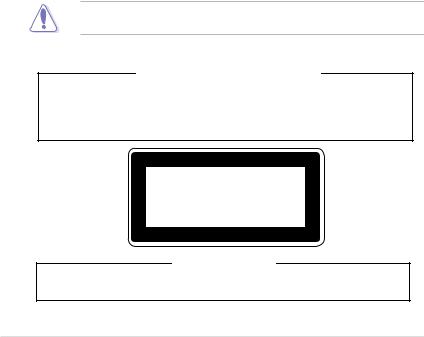
Safety information
Electrical Safety
•Before installing or removing signal cables, ensure that the power cables for the system unit and all attached devices are unplugged.
•To prevent electrical shock hazard, disconnect the power cable from the electrical outlet before relocating the system.
•When adding or removing any additional devices to or from the system, ensure that the power cables for the devices are unplugged before the signal cables are connected. If possible, disconnect all power cables from the existing system before you add a device.
•If the power supply is broken, do not try to fix it by yourself. Contact a qualified service technician or your dealer.
Operation Safety
•Any mechanical operation on this server must be conducted by certified or experienced engineers.
•Before operating the server, carefully read all the manuals included with the server package.
•Before using the server, ensure all cables are correctly connected and the power cables are not damaged. If any damage is detected, contact your dealer as soon as possible.
•To avoid short circuits, keep paper clips, screws, and staples away from connectors, slots, sockets and circuitry.
•Avoid dust, humidity, and temperature extremes. Place the server on a stable surface.
This product is equipped with a three-wire power cable and plug for the user’s safety. Use the power cable with a properly grounded electrical outlet to avoid electrical shock.
Lithium-Ion Battery Warning
CAUTION! Danger of explosion if battery is incorrectly replaced. Replace only with the same or equivalent type recommended by the manufacturer. Dispose of used batteries according to the manufacturer’s instructions.
CLASS 1 LASER PRODUCT
Heavy System
CAUTION! This server system is heavy. Ask for assistance when moving or carrying the system.
viii

DO NOT throw the motherboard in municipal waste. This product has been designed to enable proper reuse of parts and recycling. This symbol of the crossed out wheeled bin indicates that the product (electrical and electronic equipment) should not be placed in municipal waste. Check local regulations for disposal of electronic products.
DO NOT throw the mercury-containing button cell battery in municipal waste. This symbol of the crossed out wheeled bin indicates that the battery should not be placed in municipal waste.
Australia statement notice
From 1 January 2012 updated warranties apply to all ASUS products, consistent with the
Australian Consumer Law. For the latest product warranty details please visit https://www. asus.com/support. Our goods come with guarantees that cannot be excluded under the Australian Consumer Law. You are entitled to a replacement or refund for a major failure and compensation for any other reasonably foreseeable loss or damage. You are also entitled
to have the goods repaired or replaced if the goods fail to be of acceptable quality and the failure does not amount to a major failure.
If you require assistance please call ASUS Customer Service 1300 2787 88 or visit us at https://www.asus.com/support
ix

About this guide
Audience
This user guide is intended for system integrators, and experienced users with at least basic knowledge of configuring a server.
Contents
This guide contains the following parts:
1.Chapter 1: Product Introduction
This chapter describes the general features of the server, including sections on front panel and rear panel specifications.
2.Chapter 2: Hardware Information
This chapter lists the hardware setup procedures that you have to perform when installing or removing system components.
3.Chapter 3: Installation Options
This chapter describes how to install optional components into the barebone server.
4.Chapter 4: Motherboard Information
This chapter gives information about the motherboard that comes with the server. This chapter includes the motherboard layout, jumper settings, and connector locations.
5.Chapter 5: BIOS Information
This chapter tells how to change system settings through the BIOS Setup menus and describes the BIOS parameters.
6.Chapter 6: RAID Configuration
This chapter tells how to change system settings through the BIOS Setup menus. Detailed descriptions of the BIOS parameters are also provided.
7Chapter 7: Driver Installation
This chapter provides instructions for installing the necessary drivers for different system components.
x

Conventions
To ensure that you perform certain tasks properly, take note of the following symbols used throughout this manual.
DANGER/WARNING: Information to prevent injury to yourself when trying to complete a task.
CAUTION: Information to prevent damage to the components when trying to complete a task.
IMPORTANT: Instructions that you MUST follow to complete a task.
NOTE: Tips and additional information to help you complete a task.
Typography
Bold text |
Indicates a menu or an item to select. |
Italics |
Used to emphasize a word or a phrase. |
<Key> |
Keys enclosed in the less-than and greater-than |
|
sign means that you must press the enclosed key. |
|
Example: <Enter> means that you must press |
|
the Enter or Return key. |
<Key1>+<Key2>+<Key3> |
If you must press two or more keys simultaneously, |
|
the key names are linked with a plus sign (+). |
|
Example: <Ctrl>+<Alt>+<Del> |
Command |
Means that you must type the command |
|
exactly as shown, then supply the required |
|
item or value enclosed in brackets. |
|
Example: At the DOS prompt, type the |
|
command line: format A:/S |
References
Refer to the following sources for additional information, and for product and software updates.
1.ASUS Control Center (ACC) user guide
This manual tells how to set up and use the proprietary ASUS server management utility. Visit asuscontrolcenter.asus.com for more information.
2.ASUS websites
The ASUS websites worldwide provide updated information for all ASUS hardware and software products. Refer to the ASUS contact information.
xi

xii
Product Introduction |
1 |
This chapter describes the general features of the chassis kit. It includes sections on front panel and rear panel specifications.

1.1System package contents
Check your system package for the following items.
Model Name |
RS720Q-E9-RS8 |
RS720Q-E9-RS8-S |
|
|
|
Chassis |
ASUS 2U Rackmount Chassis |
|
Motherboard |
ASUS Z11PH-D12 Server Board |
|
|
2 x 1600/2200W Power Supply |
2 x 1600/2200W Power Supply |
|
4 x PCIe Riser Card (RE16L-R21L) |
4 x PCIe Riser Card (RE16L-R21L) |
|
2 x Front Panel Board (LED Board, |
2 x Front Panel Board (LED Board, |
|
FPB-R2H-A) |
FPB-R2H-A) |
|
2 x Power Supply Distribution Board |
2 x Power Supply Distribution Board |
|
(PDB-R2H-A) |
(PDB-R2H-A) |
|
1 x Power Connection Board |
1 x Power Connection Board |
Component |
(PSB-R2H-A) |
(PSB-R2H-A) |
|
|
|
|
1 x Backplane Board |
1 x Backplane Board |
|
(BP8LE12G-25-R2H-A) |
(BP8LE12G-25-R2H-A) |
|
2 x Midplane Board (MP4LE8LA- |
2 x Midplane Board |
|
R2H-A) |
(MP4LE16LX12G-R2H-A) |
|
2 x Back plane Fans (40mm x 28mm) |
2 x Back plane Fans (40mm x 28mm) |
|
4 x System Fans (80mm x 38mm) |
4 x System Fans (80mm x 38mm) |
|
8 x Hot-swap 2.5” Storage Bays |
8 x Hot-swap 2.5” Storage Bays |
|
|
|
|
1 x ASUS RS720Q-E9-RS8 Series Support DVD (includes User Guide) |
|
|
8 x CPU Heatsinks |
|
|
1 x Bag of Screws |
|
Accessories |
2 x AC Power Cables |
|
|
1 x Friction Rail Kit |
|
|
8 x LGA3647-P0 NRW-NF-CPU Carrier (Barebone) |
|
|
4 x LGA3647-P0 NRW-F-CPU Carrier (Barebone) |
|
|
|
|
If any of the above items is damaged or missing, contact your retailer.
1-2 |
Chapter 1: Product Introduction |

1.2Serial number label
Please take note of the product’s serial number. The Serial number contains 12 characters such as xxS0xxxxxxxx similar to the figure shown below.
You need to provide the correct serial number to the ASUS Technical Support team member if you need assistance or, when requesting support.
RS720Q-E9-RS8
xxS0xxxxxxxx
RS720Q-E9-RS8-S
xxS0xxxxxxxx
RS720Q-E9-RS8 Series |
1-3 |

1.3System specifications
The ASUS RS720Q-E9-RS8 Series is a 2U server system featuring the ASUS Z11PH-D12 Server Board. The server supports Intel® Xeon® processor Scalable family plus other latest technologies through the chipsets onboard.
Model Name |
|
RS720Q-E9-RS8 |
RS720Q-E9-RS8-S |
|
|
|
|
|
|
|
|
2 x Socket P0 (LGA 3647) per Node |
||
Processor Support / System |
1st Gen Intel® Xeon® processor Scalable family (Up to 165W) |
|||
Bus |
|
2nd Gen Intel® Xeon® processor Scalable family (Up to 165W) |
||
|
|
UPI 10.4 GT/s |
|
|
Core Logic |
|
Intel® C621 PCH |
|
|
|
Fan Speed |
|
|
|
ASUS |
Control |
|
|
|
Features |
ASWM |
|
|
|
|
Enterprise |
|
|
|
|
Total Slots |
12 (6-channel per CPU, 6 DIMM per CPU) |
||
|
Capacity |
Maximum up to 3072GB |
|
|
|
|
DDR4 2933 (1 DIMM per Channel) |
||
|
Memory Type |
DDR4 2666 / 2400 / 2133 RDIMM / LR-DIMM / LR-DIMM 3DS |
||
|
|
|
||
|
|
* 2933MHz will drop to 2666MHz when using 2DPC configurations. |
||
Memory |
|
* Refer to ASUS server AVL for the latest update |
||
|
|
4GB, 8GB, 12GB, 32GB (RDIMM) |
||
|
|
64GB, 128GB (RDIMM 3DS) |
|
|
|
Memory Size |
32GB, 64GB, 128GB (LRDIMM) |
|
|
|
|
64GB, 128GB, 256GB (LRDIMM 3DS) |
||
|
|
* Refer to ASUS server AVL for the latest update |
||
|
Total PCI/ |
1+1 per node |
|
|
|
PCI-E Slots |
|
||
|
|
|
||
Expansion |
|
Per Node: |
|
|
Slots |
|
|
||
Slot Type |
1 x PCI-E x16 (Gen3 x16 link), LP, HL |
|||
|
||||
|
|
1 x OCP 2.0 Mezzanine (Gen3 x16 link) |
||
|
|
Per Mid Plane: |
Per Mid Plane: |
|
|
|
Marvell® 88SE9230 |
LSI SAS3008 |
|
|
|
- 4 x SATA 6Gb/s ports |
- 8 x SATA 6Gb/s ports (by 2 |
|
|
|
(by 1 Oculink Connector) |
Oculink Connectors) |
|
|
SATA Controller |
- 2 x Oculink ports |
- 2 x Oculink ports |
|
Storage |
Marvell® RAID |
LSI RAID |
||
|
|
Intel® VROC |
(Support hardware RAID 0, 1, 10) |
|
|
|
(for Windows only; Support |
Intel® VROC |
|
|
|
software RAID 0, 1, 10 & 5) |
(for Windows only; Support |
|
|
|
|
||
|
|
|
software RAID 0, 1, 10 & 5) |
|
|
SAS Upgrade |
Not supported |
12G SAS Support |
|
(continued on the next page)
1-4 |
Chapter 1: Product Introduction |

Model Name |
|
RS720Q-E9-RS8 |
|
RS720Q-E9-RS8-S |
|
|
|
|
|
HDD Bays |
|
8 x 2.5" Hot-swap Storage Bays* (8 NVMe Supported) |
||
|
* CPU2 is necessary in order to support front hot-swap bays. |
|||
|
|
|||
|
|
Per Node: |
|
|
Networking |
LAN |
1 x Dual Port Intel I350-AM2 Gigabit LAN controller |
||
|
|
1 x Management Port |
|
|
Graphic |
VGA |
Aspeed AST2500 64MB |
|
|
|
|
Per Node: |
|
|
|
|
2 x USB 3.0 ports |
|
|
Rear I/O Connectors |
1 x VGA port |
|
||
|
|
2 x RJ-45 GbE LAN ports |
|
|
|
|
1 x RJ-45 Mgmt LAN port |
|
|
|
|
Per Node: |
|
|
|
|
Rear Switch/LED: |
|
|
|
|
1 x Q-Code/Port 80 LED |
|
|
|
|
1 x Power switch LED |
|
|
Switch/LED |
|
Front Switch/LED: |
|
|
|
|
|
||
|
|
1 x Power switch/LED |
|
|
|
|
1 x Location switch/LED |
|
|
|
|
1 x Message LED |
|
|
|
|
LAN 1-2 LED |
|
|
Management |
Software |
ASUS Control Center (Classic) |
|
|
Out of Band |
|
|
|
|
Solution |
Remote |
On-Board ASMB9-iKVM for KVM-over-IP |
|
|
|
Management |
|
|
|
|
|
Windows® Server 2016 |
|
|
|
|
Windows® Server 2012 R2 |
|
|
|
|
RedHat® Enterprise Linux |
|
|
|
|
SuSE® Linux Enterprise Server |
|
|
OS support |
|
CentOS |
|
|
|
|
Ubuntu |
|
|
|
|
VMware |
|
|
|
|
Citrix XenServer |
|
|
|
|
* Please find the latest OS support from http://www.asus.com/ |
||
|
|
(continued on the next page) |
|
|
RS720Q-E9-RS8 Series |
1-5 |

Model Name |
RS720Q-E9-RS8 |
|
RS720Q-E9-RS8-S |
|
|
|
|
|
|
Regulatory Compliance |
BSMI, CE, C-TICK, FCC (ClassA) |
|
||
|
|
|
||
Dimension |
800mm x 444mm x 88mm(2U) |
|
||
31.5" x 17.48" x 3.46" |
|
|||
|
|
|||
Gross Weight Kg |
41.5 kg |
|
||
|
|
|
||
Net Weight Kg (CPU, DRAM, |
32.5 kg |
|
||
and HDD not included) |
|
|
|
|
Power Supply |
1+1 Redundant 1600/2200W 80 PLUS Platinum Power Supply |
|||
(following different |
||||
Rating: 200-240Vac, 9.5A/12.6A (for each inlet), 47-63Hz, Class I |
||||
configuration by region) |
||||
|
|
|
||
|
Operation temperature: 10° ~ 35° |
|
||
Environment |
Non operation temperature: -40° ~ 60° |
|
||
|
Non operation humidity: 20% ~ 90% ( Non condensing) |
|||
Specifications are subject to change without notice.
1-6 |
Chapter 1: Product Introduction |

1.4Front panel features
The barebone server displays easily accessible features such as the power and reset buttons, LED indicators, and optical drive.
Refer to the Front panel LEDs section for the LED descriptions.
Front panel |
|
Node 1 |
Node 3 |
|
|
|
|||||||||
(Bay 1 |
- 2) |
(Bay 5 - 6) |
|
|
|
||||||||||
Node 2 |
Front panel |
||||||||||||||
|
|
|
|
|
|
|
|
|
|||||||
|
|
|
|
|
|
|
|
|
|
|
|
Node 4 |
|||
|
|
|
|
|
|
|
|
|
|
|
|
|
|
|
|
|
|
|
|
|
|
|
|
|
|
|
|
|
|
|
|
|
|
|
|
|
|
|
|
|
|
|
|
|
|
|
|
|
|
|
|
|
|
|
|
|
|
|
|
|
|
|
|
|
|
|
|
|
|
|
|
|
|
|
|
|
|
|
|
|
|
Front panel |
Front panel |
|
Node 3 |
Node 1 |
Node 2 |
Node 4 |
|
(Bay 3 - 4) |
(Bay 7 - 8) |
Asset tag |
|
|
Turn off the system power and detach the power supply before removing or replacing any system component.
Asset tag
The Asset tag is a small polyester film located on the right side of the server’s front panel. It provides information about the server such as asset barcode or serial number and is useful in asset tracking and inventory management.
RS720Q-E9-RS8 Series |
1-7 |
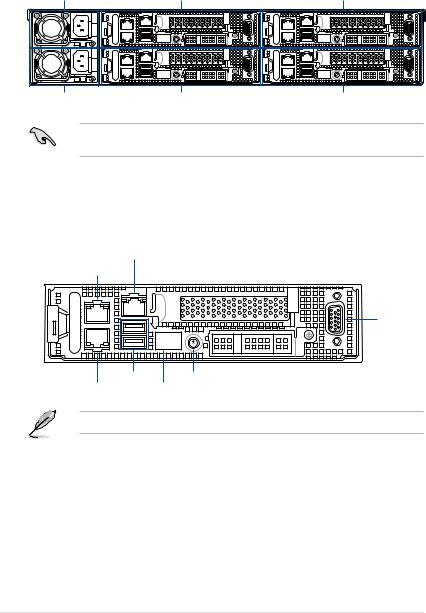
1.5Rear panel features
RS720Q-E9-RS8 / RS720Q-E9-RS8-S |
|
|
PSU 2 |
Node 4 |
Node 2 |
PSU 1 |
Node 3 |
Node 1 |
When installing only two nodes, install the nodes to node slot number 1 and 3 or number 2 and 4.
Z11PH-D12 (Node)
DM management LAN port*
LAN port 2
VGA port
USB 3.0 ports Power button
LAN port 1 Q-Code/Port 80 LED
*This port is for ASUS ASMB9-iKVM controller and for technicians only.
1-8 |
Chapter 1: Product Introduction |
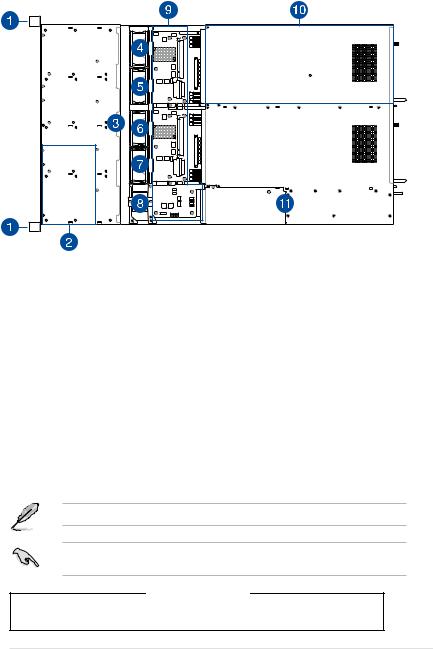
1.6Internal features
The barebone server includes the basic components as shown.
1.Front LED Boards
2.Hot-swap storage device trays
3.Backplane
4.System fan (SYS_FAN1)
5.System fan (SYS_FAN2)
6.System fan (SYS_FAN3)
7.System fan (SYS_FAN4)
8.BP_FAN1 (top) and BP_FAN2 (bottom)
9.SATA/NVMe Mid-plane (for RS720Q-E9-RS8) or SATA/SAS/NVMe Mid-plane (for RS720Q-E9-RS8-S)
10.ASUS Z11PH-D12 Server Board
11.Power supply and power fan
Ensure that the air duct is positioned on the gaps between the memory slots.
Turn off the system power and detach the power supply before removing or replacing any system component.
*WARNING HAZARDOUS MOVING PARTS
KEEP FINGERS AND OTHER BODY PARTS AWAY
RS720Q-E9-RS8 Series |
1-9 |
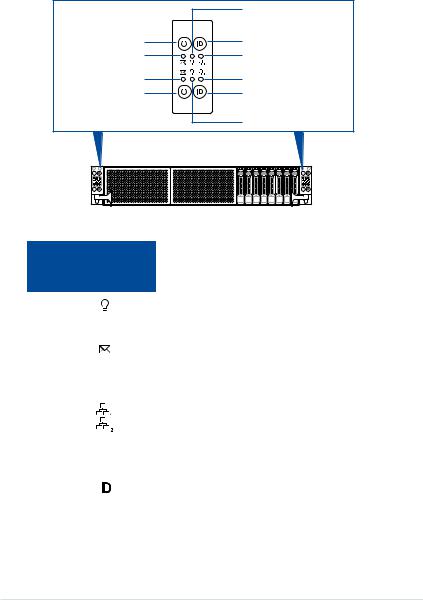
1.7LED information
1.7.1Front panel LEDs
|
|
|
LAN1 LED |
Power button with LED |
|
|
Location button with LED |
Message LED |
|
|
LAN2 LED |
|
1 |
2 |
|
Message LED |
1 |
2 |
LAN2 LED |
|
|
||
Power button with LED |
|
|
Location button with LED |
|
|
|
LAN1 LED |
LED |
Icon |
Display |
Description |
||
status |
|||||
|
|
|
|
|
|
Power LED |
|
|
ON |
System power ON |
|
|
|
|
|
|
|
|
|
|
OFF |
System is normal; no incoming event |
|
Message LED |
|
|
|
|
|
|
|
ON |
A hardware monitor event is indicated |
||
|
|
|
|||
|
|
|
|
|
|
|
|
|
OFF |
No LAN connection |
|
LAN LEDs |
|
|
|
|
|
|
|
Blinking |
LAN is transmitting or receiving data |
||
|
|
|
|
|
|
|
|
|
ON |
LAN connection is present |
|
|
|
|
|
|
|
|
|
|
ON |
Location switched is pressed |
|
Location LED |
|
|
|
|
|
|
|
|
|
|
|
|
|
OFF |
Normal status (Press the location switch again to turn off.) |
||
|
|
|
|||
|
|
|
|
|
|
1-10 |
Chapter 1: Product Introduction |
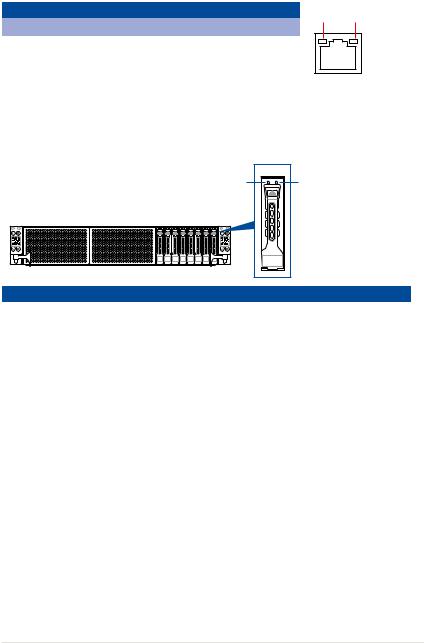
1.7.2LAN (RJ-45) LEDs
LAN port LED indications
Activity/Link LED |
|
Speed LED |
||
Status |
Description |
Status |
|
Description |
OFF |
No link |
OFF |
|
10 Mbps connection |
GREEN |
Linked |
ORANGE |
|
100 Mbps connection |
BLINKING |
Data activity |
GREEN |
|
1 Gbps connection |
ACT/LINK SPEED LED LED
LAN port
1.7.3HDD status LEDs
Status LED |
Active LED |
HDD LED |
|
|
Description |
|
|
OFF |
|
HDD not present |
|
HDD Activity LED |
ON |
|
HDD present, no activity |
|
(Green) |
|
|
|
|
Blinking |
|
1. Read/write data from/into the storage device |
||
|
|
|||
|
|
2. Locating (blinking with the HDD status LED) |
||
|
|
|
||
|
GREEN |
ON |
Storage device power ON |
|
|
|
|
|
|
|
RED |
ON |
HDD has failed and should be swapped immediately |
|
HDD Status LED |
|
|
|
|
GREEN/ |
Blinking |
RAID rebuilding |
||
|
||||
|
RED |
|
|
|
|
GREEN/ |
OFF |
HDD not found |
|
|
RED |
|
|
RS720Q-E9-RS8 Series |
1-11 |

1.7.4Q-Code table
Action |
PHASE |
POST CODE |
TYPE |
DESCRIPTION |
|
|
01 |
Progress |
First post code(POWER_ON_POST_CODE) |
|
|
02 |
Progress |
Load BSP microcode(MICROCODE_POST_CODE) |
|
Security Phase |
03 |
Progress |
Set cache as ram for PEI phase(CACHE_ENABLED_POST_CODE) |
|
|
06 |
Progress |
CPU Early init.(CPU_EARLY_INIT_POST_CODE) |
|
|
04 |
Progress |
initializes South bridge for PEI preparation |
|
|
10 |
Progress |
PEI Core Entry |
|
|
15 |
Progress |
NB initialize before installed memory |
|
|
19 |
Progress |
SB initialize before installed memory |
|
|
78~00 |
Progress |
Wait BMC ready(duration: 120 seconds). |
|
|
A1 |
MRC Progress |
QPI initialization |
|
|
A3 |
MRC Progress |
QPI initialization |
|
|
A7 |
MRC Progress |
QPI initialization |
|
|
A8 |
MRC Progress |
QPI initialization |
|
|
A9 |
MRC Progress |
QPI initialization |
|
|
AA |
MRC Progress |
QPI initialization |
|
|
AB |
MRC Progress |
QPI initialization |
|
|
AC |
MRC Progress |
QPI initialization |
|
|
AD |
MRC Progress |
QPI initialization |
|
|
AE |
MRC Progress |
QPI initialization |
|
|
AF |
MRC Progress |
QPI initialization Complete |
Normal boot |
|
2F |
Progress |
Memory Init. |
|
B0 |
MRC Progress |
Memory Init. |
|
|
|
|||
|
PEI(Pre-EFI |
B1 |
MRC Progress |
Memory Init. |
|
AF |
MRC Progress |
RC Reset if require |
|
|
initialization) phase |
|||
|
B4 |
MRC Progress |
Memory Init. |
|
|
|
|||
|
|
B2 |
MRC Progress |
Memory Init. |
|
|
B3 |
MRC Progress |
Memory Init. |
|
|
B5 |
MRC Progress |
Memory Init. |
|
|
B6 |
MRC Progress |
Memory Init. |
|
|
B7 |
MRC Progress |
Memory Init. |
|
|
B8 |
MRC Progress |
Memory Init. |
|
|
B9 |
MRC Progress |
Memory Init. |
|
|
BA |
MRC Progress |
Memory Init. |
|
|
BB |
MRC Progress |
Memory Init. |
|
|
BC |
MRC Progress |
Memory Init. |
|
|
BF |
MRC Progress |
Memory Init. Done |
|
|
5A |
MRC Progress |
Other config. After RC end |
|
|
31 |
Progress |
Memory already installed. |
|
|
32 |
Progress |
CPU Init. |
|
|
34 |
Progress |
CPU Init. |
|
|
36 |
Progress |
CPU Init. |
|
|
4F |
Progress |
DXE Initial Program Load(IPL) |
(continued on the next page)
1-12 |
Chapter 1: Product Introduction |

Q-Code table
Action |
PHASE |
POST CODE |
TYPE |
DESCRIPTION |
|
|
60 |
Progress |
DXE Core Started |
|
|
61 |
Progress |
DXE NVRAM Init. |
|
|
62 |
Progress |
SB run-time init. |
|
|
63 |
Progress |
DXE CPU Init |
|
|
68 |
Progress |
NB Init. |
|
DXE(Driver |
69 |
Progress |
NB Init. |
|
Execution |
|
|
|
|
6A |
Progress |
NB Init. |
|
|
Environment) phase |
|||
|
|
70 |
Progress |
SB Init. |
|
|
71 |
Progress |
SB Init. |
|
|
72 |
Progress |
SB Init. |
|
|
78 |
Progress |
ACPI Init. |
|
|
79 |
Progress |
CSM Init. |
|
|
90 |
Progress |
BDS started |
|
|
91 |
Progress |
Connect device event |
|
|
92 |
Progress |
PCI Bus Enumeration. |
|
|
93 |
Progress |
PCI Bus Enumeration. |
|
|
94 |
Progress |
PCI Bus Enumeration. |
|
|
95 |
Progress |
PCI Bus Enumeration. |
|
|
96 |
Progress |
PCI Bus Enumeration. |
|
|
97 |
Progress |
Console outout connect event |
Normal boot |
|
98 |
Progress |
Console input connect event |
|
99 |
Progress |
AMI Super IO start |
|
|
|
|||
|
|
9A |
Progress |
AMI USB Driver Init. |
|
|
9B |
Progress |
AMI USB Driver Init. |
|
|
9C |
Progress |
AMI USB Driver Init. |
|
BDS(Boot Device |
9D |
Progress |
AMI USB Driver Init. |
|
Selection) phase |
b2 |
Progress |
Legacy Option ROM Init. |
|
|
b3 |
Progress |
Reset system |
|
|
b4 |
Progress |
USB hotplug |
|
|
b6 |
Progress |
NVRAM clean up |
|
|
b7 |
Progress |
NVRAM configuration reset |
|
|
A0 |
Progress |
IDE, AHCI Init. |
|
|
A1 |
Progress |
IDE, AHCI Init. |
|
|
A2 |
Progress |
IDE, AHCI Init. |
|
|
A3 |
Progress |
IDE, AHCI Init. |
|
|
A8 |
Progress |
BIOS Setup Utility password verify |
|
|
A9 |
Progress |
BIOS Setup Utility start |
|
|
AB |
Progress |
BIOS Setup Utility input wait |
|
|
AD |
Progress |
Ready to boot event |
|
|
AE |
Progress |
Legacy boot event |
|
Operating system |
AA |
Progress |
APIC mode |
|
phase |
AC |
Progress |
PIC mode |
RS720Q-E9-RS8 Series |
1-13 |

1-14 |
Chapter 1: Product Introduction |
Hardware Information |
2 |
This chapter lists the hardware setup procedures that you have to perform when installing or removing system components.
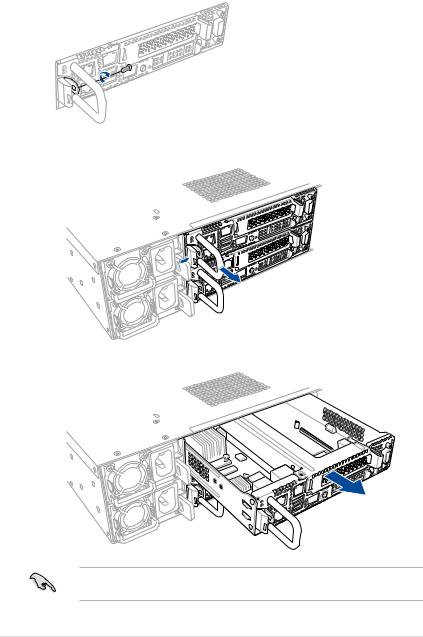
2.1Removing the server node
1.Remove the screw located on the node latch.
2.Hold the server node lever and press the green node latch.
3.Firmly pull the server node out of the server chassis.
When installing only two nodes, install the nodes to node slot number 1 and 3 or number 2 and 4. Refer to section 1.5 Rear panel features for details.
2-2 |
Chapter 2: Hardware Information |
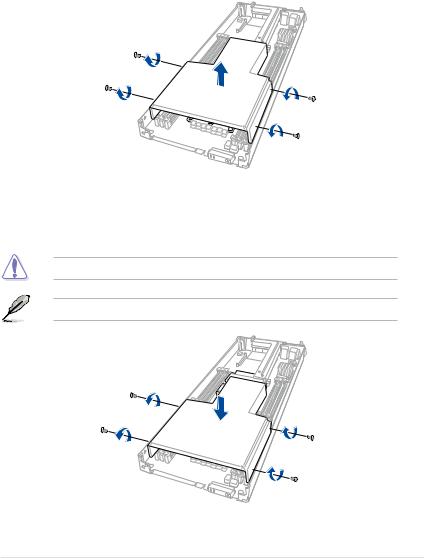
2.2Air Duct
The RS720Q-E9-RS8 series server system comes with a motherboard fan air duct to enable better air flow inside the motherboard while the system is running.
Removing the air duct
1.Remove the screws securing the air duct in place.
2.Carefully lift the air duct out of the chassis.
Installing the air duct
Position the air duct on top of the motherboard then carefully fit it on top of the motherboard.
Refer to the following illustration for the right orientation of the air duct.
Insert the air duct on the gaps between the memory slots.
Ensure that the air duct is firmly fitted to the motherboard.
RS720Q-E9-RS8 Series |
2-3 |
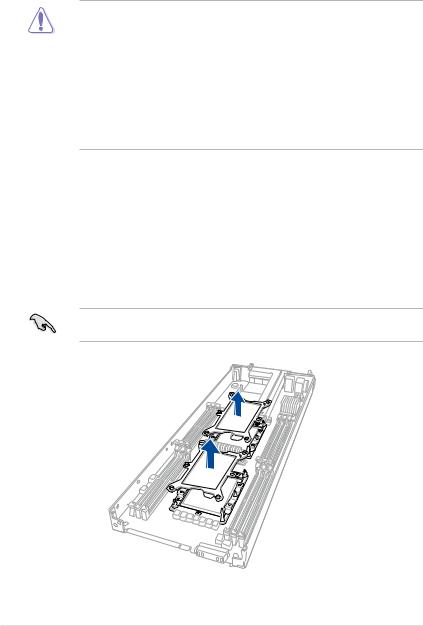
2.3Central Processing Unit (CPU)
The motherboard comes with a surface mount LGA 3647 socket designed for the Intel® Xeon® Skylake-F/SP product family series processors.
•Upon purchase of the motherboard, ensure that the PnP cap is on the socket and the socket contacts are not bent. Contact your retailer immediately if the PnP cap
is missing, or if you see any damage to the PnP cap/socket contacts/motherboard components. ASUS will shoulder the cost of repair only if the damage is shipment/ transit-related.
•Keep the cap after installing the motherboard. ASUS will process Return Merchandise Authorization (RMA) requests only if the motherboard comes with the cap on the LGA
3647 socket.
•The product warranty does not cover damage to the socket contacts resulting from incorrect CPU installation/removal, or misplacement/loss/incorrect removal of the PnP cap.
2.3.1Installing the CPU and heatsink
To install a CPU:
1.Remove the server node. For more information, see the section Removing the server node.
2.Remove the air duct. For more information, see the section Air Duct.
3.Remove the PnP caps from the CPU sockets.
Keep the PnP cap. ASUS will process Return Merchandise Authorization (RMA) requests only if the motherboard comes with the PnP cap on the LGA 3647 socket.
2-4 |
Chapter 2: Hardware Information |
